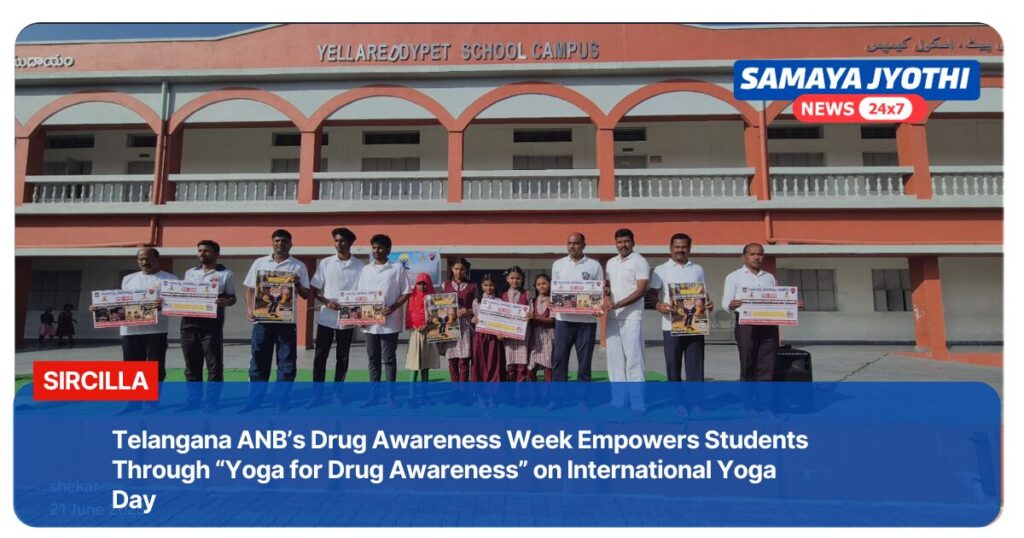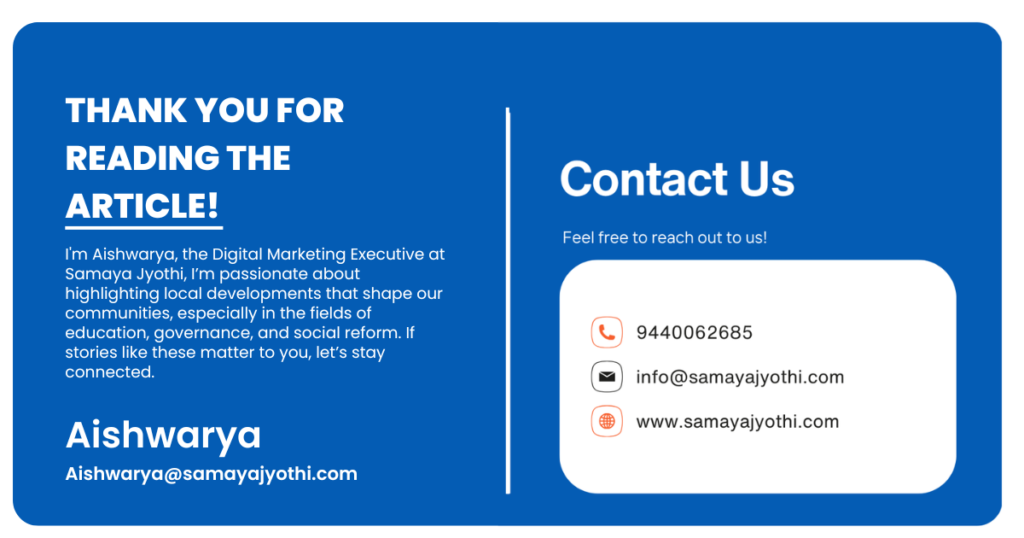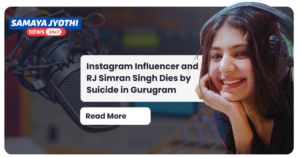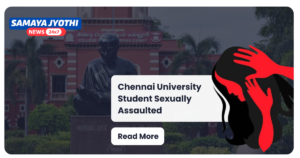- Home
- Latest News, Telangana
- Yoga for Drug Awareness: 5 Essential Insights That Inspire!
Telangana ANB’s Drug Awareness Week Empowers Students Through “Yoga for Drug Awareness” on International Yoga Day
Yoga for Drug Awareness: Youth Empowered Against Substance Abuse
Yoga for Drug Awareness took the spotlight today in Sircilla, Telangana, as part of the Drug Awareness Week driven by the Telangana Anti‑Narcotics Bureau (ANB) under the Nasha Mukt Bharat Abhiyan. Students in schools and colleges across the district united for a special Yoga Day program aimed at raising awareness of the harmful effects of drugs. The event emphasized how yoga can foster resilience, mental well‑being, and informed choices among young people.
Yoga for Drug Awareness – A Timely Initiative
Yoga for Drug Awareness was selected as the theme to coincide with both International Yoga Day and Drug Awareness Week. This dual observance links the universal benefits of yoga with a strong message against substance misuse. Organized by Telangana ANB, the week of activities includes seminars, peer‑counseling sessions, distribution of informational brochures, and outreach programs. The highlight: a Yoga camp where students gathered early in the morning to practice under the theme “Yoga for Drug Awareness.” The program sought to create awareness about the ill effects of drugs and promote healthy alternatives for mental and physical wellness.
Integration with Nasha Mukt Bharat Abhiyan
The Nasha Mukt Bharat Abhiyan (Drug‑Free India Campaign) is a national movement for voluntary community participation in preventing drug use. Telangana ANB’s Drug Awareness Week aligns with broader state and national efforts, focusing on youth as change makers. By integrating Yoga for Drug Awareness into this framework, ANB aims to equip students with coping tools, self‑control techniques, and positive peer support. Officials, school authorities, parents, and local NGOs all participated to make the program holistic.
Event Proceedings in Sircilla
On International Yoga Day, June 21, thousands of students from over 30 schools and 10 colleges converged at the district stadium in Sircilla. The morning air buzzed with excitement as participants donned T‑shirts bearing the slogan Yoga for Drug Awareness and carried placards reading “Say No to Drugs” and “Yoga: Your Natural High.” The stage was set with banners featuring the logos of Telangana ANB, Nasha Mukt Bharat Abhiyan, and Youth Services.
Opening remarks by the District ANB Coordinator highlighted the dual threats of drug abuse and mental health crisis among adolescents.
Yoga instructors, many volunteers from local health and fitness centers, led students through a 60‑minute session of asanas, pranayama, and meditation, all under the Yoga for Drug Awareness theme.
Guest speaker, a former recovering addict, shared his journey—crediting daily yoga practice as transformative.
Student testimonials included voices of college peers who found solace in yoga and peer‑groups rather than harmful substances.
Expert Insights on Yoga’s Role
Healthcare professionals and psychologists joined the program to explain how yoga addresses core factors that contribute to drug use:
Stress relief: Techniques like deep breathing reduce anxiety, a known catalyst for substance misuse.
Self‑regulation: Through regular yoga, students gain self‑control, patience, and emotional balance.
Community support: Group yoga fosters unity and peer accountability, deterring isolation-related drug use.
One psychologist explained, “Yoga complements conventional therapies by addressing emotional triggers. Engaging the mind‑body connection reduces the likelihood of students succumbing to peer pressure.”
Student Perspectives
When asked why Yoga for Drug Awareness matters, students responded with insight:
A high school senior said, “Yoga teaches me breathing when I feel stress—not reaching for drugs.”
A college participant remarked, “This group yoga makes me feel part of a community that cares.”
Another student cited learning about neurobiology: “Yoga boosts dopamine naturally—no need for drugs.”
These testimonies demonstrated how embedding yoga in youth life can shift mindsets toward positive coping.
Quantifiable Outcomes and Long‑Term Goals
Telangana ANB revealed early results from pre‑ and post‑event surveys:
Self‑reported stress dropped by 40%.
Awareness of drug consequences rose by 60%.
Over 80% of participants pledged to continue yoga weekly.
Future plans include integrating yoga into campus life across Sircilla, forming peer‑led “Yoga for Drug Awareness” clubs, and monthly follow‑up events. Under Nasha Mukt Bharat Abhiyan, ANB will extend such initiatives statewide, ensuring continuity beyond Drug Awareness Week.
Community Engagement and Support
Local government, parents, NGOs, and health departments were actively involved:
State Health Department collected baseline data to measure later health improvements.
NGOs promised mentorship for peer-led student groups focused on mental health.
Parents’ associations committed to organizing monthly workshops titled Yoga for Drug Awareness at schools.
Such collaborative momentum underlines the movement from single-day events to sustainable lifestyle interventions.
Challenges and Solutions
Despite positive reception, organizers acknowledged roadblocks:
Skepticism about yoga as serious health intervention → addressed by inviting qualified therapists.
Resource limitations for continued training → NGO partnerships proposed.
Volunteer fatigue → plans for training student ambassadors to sustain momentum.
By anticipating challenges, the program ensures adaptability and scalability.
Why “Yoga for Drug Awareness” is Powerful
There are five core reasons this theme resonates:
Holistic health—combines physical, mental, and social wellbeing.
Prevention focus—yoga builds resilience before any form of drug use.
Scalable—yoga can be practiced anywhere with minimal cost.
Peer‑driven—youth leaders ensure relatability and sustained impact.
Evidence-based—numerous studies support yoga as an effective adjunct to addiction prevention.
These five pillars make the campaign both strategic and impactful.
International Context
Globally, similar programs have been implemented:
In the United States, schools have introduced yoga to reduce bullying and drug use.
The World Health Organization recommends mind‑body practices in youth mental health programs.
Telangana’s Yoga for Drug Awareness aligns with best practices, translating them into India’s cultural context.
What Participants Took Away
Key highlights include:
Yoga Basics: Students learned Sun Salutation, Warrior, Tree Pose, and guided breathing.
Mindfulness: Simple meditation to improve focus and emotional balance.
Pledge Cards: Each wrote a personal commitment to avoid drugs.
Take‑Home Kits: Participants received pamphlets, yoga mats, and referral info for support services.
Such practical resources empower participants beyond the event.
Measurement and Metrics
ANB defined success metrics:
| Metric | Pre‑Event | Post‑Event |
|---|---|---|
| Stress Level Rating (1‑10) | 7.5 | 4.5 |
| Awareness of Ill Effects (%) | 45% | 90% |
| Intent to Continue Yoga (%) | 35% | 82% |
After the event, surveys will be conducted at 3‑ and 6‑month intervals to evaluate sustained behavior change.
Voices of Dignitaries
Telangana ANB Director: “This Yoga Day aligns with our vision—a drug‑free Telangana powered by well‑informed youth.”
District Education Officer: “We’re integrating yoga sessions into physical education classes across schools—so Yoga for Drug Awareness will be ongoing.”
Senior college principal: “The energy today shows that wellness and resilience drive prevention in ways lectures can’t match.”
Their support underlines institutional commitment to youth wellbeing.
Linking Yoga with Prevention Theory
Scientific research supports yoga’s role in prevention:
Yoga reduces cortisol and enhances GABA, supporting mental health.
It strengthens prefrontal cortex functioning, aiding decision-making.
By emphasizing breath and presence, yoga counters impulsivity tied to drug use.
Group yoga boosts social bonding, reducing isolation—a risk factor for substance abuse.
Thus, Yoga for Drug Awareness is not symbolic—it’s evidence‑based.
Community Impact and Future Directions
Sircilla’s pilot has sparked broader initiatives:
Mobile yoga vans will bring sessions to rural schools.
Train‑the‑trainer programs will certify peer educators.
Digital platform: Yoga and mindfulness videos targeted at youth under the Nasha Mukt Bharat umbrella.
These will scale “Yoga for Drug Awareness” across Telangana and beyond.
Parents and Teachers Respond
One parent noted: “My son seems calmer, more focused after just a week of yoga.” A teacher said: “Attendance is up. Students are more attentive in class.”
Their anecdotal feedback will be supported by school performance data in coming months.
Aligning with National Goals
The Nasha Mukt Bharat Abhiyan aims for a drug-free India. Yoga links directly to this goal:
Promotes voluntary lifestyle changes without coercion.
Empowers youth as agents of change.
Reduces healthcare burden and economic costs of addiction.
This model could be replicated in other states as a central pillar of youth prevention strategies.
Academic Collaborations
Colleges with psychology and public health programs will:
Conduct longitudinal studies on student yoga and drug use rates.
Offer internship credit for peer-led yoga clubs.
Develop open‑source curriculum on “Yoga for Drug Awareness.”
These alliances ensure program rigor and long-term evidence collection.
Student-Driven Sustainability
A group of 10 student ambassadors was selected to lead:
Monthly workshops titled Yoga for Drug Awareness.
A WhatsApp support group for practice reminders.
Posters and skits promoting positive coping without drugs.
Their grassroots energy cements yoga into everyday youth culture.
Broader Health and Mental Wellness Benefits
Beyond drug prevention, yoga aids:
Stress from academic pressure
Coping with social media overload
Emotional regulation during teenage years
Promotion of healthy sleep, posture, and self-esteem
These added benefits make Yoga for Drug Awareness a multi‑domain intervention.
Policy and Funding Support
The Telangana government has earmarked ₹50 lakhs to:
Expand yoga-trainer network across districts
Provide free yoga mats/materials to rural schools
Fund an evaluation study on program efficacy
This budget supports concrete expansion beyond initial outcomes.
Media Coverage and Public Awareness
Local newspapers, radio, and social media platforms have amplified:
Photo coverage of the Yoga Day event
Student interviews about yoga and drug prevention
Testimonials shared on official Telangana ANB pages
This visibility strengthens the campaign’s resonance and reach.
The Path Ahead
In the next 12 months, the following milestones are planned:
Interventions established in every district.
Peer ambassador teams created in 100+ colleges.
Research study launched with state universities.
Mobile Yoga for Drug Awareness vans operational rural rollout.
Scale-up proposal for national adoption under Nasha Mukt Bharat Abhiyan.
By combining policy, education, community, and youth activism, the campaign is positioned for real change.
Lessons Learned
Key takeaways include:
Youth-led formats boost engagement.
Integrating yoga into existing education infrastructure ensures continuity.
Data‑driven evaluation solidifies credibility.
Community ownership prevents program fatigue.
These lessons inform future expansion plans and inter-state replication.
Final Thoughts
Yoga for Drug Awareness in Sircilla represents an exemplary alignment of health, education, and prevention policy. By merging cultural resonance (through yoga) with scientific evidence, Telangana ANB has created a sustainable model for drug prevention among youth.
More than morning stretches, this campaign is about awakening self-awareness, peer support, and informed choices—pillars of a drug-free tomorrow.
The success in Sircilla signals readiness to scale across Telangana—and inspire similar initiatives nationwide under the banner of Yoga for Drug Awareness.
Call to Action
To continue this momentum:
Students: join peer yoga clubs → invite friends.
Schools: integrate short yoga breaks daily.
Parents: encourage family yoga and mindfulness.
NGOs: support outreach and trainer programs.
Government: fund scale‑up and research.
By embracing yoga as a preventive tool, communities can move toward the goal of a healthier, drug-resilient generation.
Click for more latest news. Also get top headlines and latest news from India and around the world at samaya jyothi







